Reports
Shahid Mahallati: “Temporary” Plant for Manufacturing Nuclear Weapon Cores
by David Albright, Sarah Burkhard, and Frank Pabian
April 8, 2020
Summary
Based on documents in the Iran Nuclear Archive, seized by Israel in early 2018, Iran’s Amad Plan created the Shahid Mahallati Uranium Metals Workshop near Tehran to research and develop uranium metallurgy related to building nuclear weapons. Figure 1 shows this site as it looked in 2002 and 2003, when an existing workshop was renovated and brought into operation. The facility was intended as a pilot plant, aimed at developing and making uranium components for nuclear weapons, in particular components from weapon-grade uranium, the key nuclear explosive material in Iranian nuclear weapon cores. The site was meant to be temporary, until the production-scale Shahid Boroujerdi facility at Parchin was completed.1 However, the Shahid Mahallati facility was capable of making the first cores of weapon-grade uranium, in case Shahid Boroujerdi was unfinished when weapon-grade uranium would have had become available.
The sidebar shows the Amad Plan’s pathway to nuclear weapons, based on information in the Nuclear Archive. Highlighted is the role of Shahid Mahallati in that process of making nuclear weapons.
The Amad Plan was downsized in late 2003 before this plant processed any weapon-grade uranium, although it did process a considerable amount of a non-uranium surrogate material into weapon components. The use of a surrogate material allowed Iran’s nuclear weapons program to learn and practice the fabrication of key nuclear weapon components.
Analysis of commercial satellite imagery confirms the location of the Shahid Mahallati site based on comparison with exterior ground photos, and a chronology of the site’s status is included in this report. The key building of the site, the uranium metals workshop, was apparently gutted and abandoned between late 2010 and early 2011. This action may have been triggered by the Western discovery and exposure in late 2009 of the secret, deeply buried Fordow enrichment plant, formerly called the Al Ghadir project under the Amad Plan (see sidebar).
Iran should declare this site to the International Atomic Energy Agency (IAEA) and allow its inspection, since the facility was designed and built to handle nuclear material subject to safeguards under Iran’s comprehensive safeguards agreement. The IAEA, more generally, should verify sites, locations, facilities, documentation, equipment, and materials involved in the Amad Plan activities, and urge Iran to cooperate fully in these investigations, despite their age, as part of ensuring that Iran has not continued nuclear weapons work up to today.

Sidebar. Iranian Pathway to a Nuclear Weapon Under the Amad Plan. This chart generally flows from the top to the bottom, ending with a nuclear warhead on a Shahab-3 missile. Some activities occur simultaneously and are therefore presented on the same level. A more complete, interactive pathway chart can be found in the Annex to this report. It can also be found at https://isis-online.org/isis-reports/detail/iranian-pathway1-to-a-nuclear-weapon-under-the-amad-planwhat-we-learned-fro/8
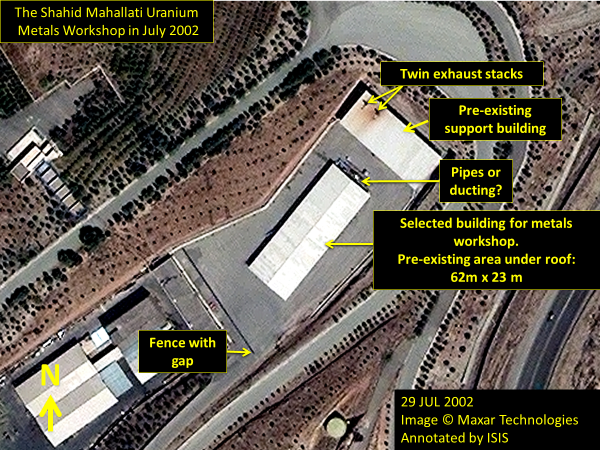
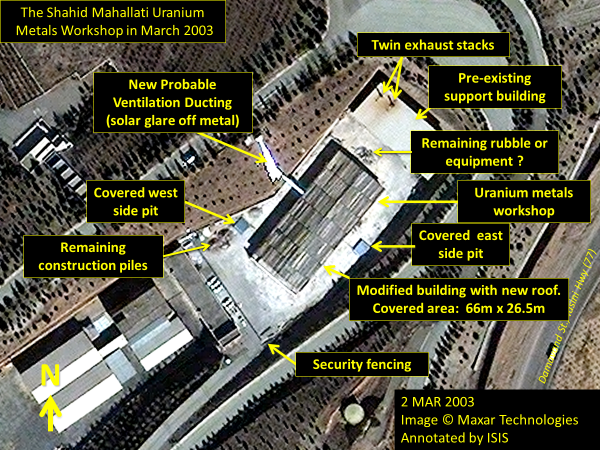
Figure 1. The Shahid Mahallati Uranium Metals Workshop. On top, a Maxar Technologies image from July 29, 2002, after the selection of the site and shortly before major renovation of the site began. On bottom, a Maxar Technologies image from March 02, 2003, after the site was re-purposed and renovated under the Amad Plan. While some features of the site remained, such as two stacks on support building, several prominent signatures were added, including two pits, a new security fence, and a metal ventilation duct. In addition, the images show that the metallurgy workshop’s roof cover was significantly expanded, with a widening and lengthening of the building (see below).
Introduction
A key part of Iran’s nuclear weapon program focused on the development and production of metal components for the core of a nuclear weapon, its core made from the key nuclear explosive material weapon-grade uranium (WGU). WGU metal parts fabrication represented one of the most critical aspects of Iran’s entire nuclear weapons project. Under the Amad Plan of the early 2000s, this work was centered in Project 3.14, a project focused on metallurgy, under Project 3, an overarching nuclear warhead program sometimes also called Project 110.2
The major thrust of Project 3.14 was the construction of the Shahid Boroujerdi facility in a tunnel complex at the Parchin site.3 Construction started in late April 2002, with a completion date uncertain, based on available information in the archive. This facility, composed of a series of underground workshops and laboratories, was designed to manufacture weapon-grade uranium components for a few nuclear weapons per year, a capacity more than sufficient to meet the Amad Plan’s initial goal of building five nuclear weapons.
Building such a production-scale uranium metallurgy plant is complicated. This plant needed to be capable of making uranium metal, melting it, casting it into molds of necessary shapes, and finishing quality-controlled weapon components, all complicated by the tendency of uranium metal to oxidize, even catch fire. There are also the issues associated with handling the waste process materials and ventilation of the off-gases.
Overcoming these difficulties would typically call for a pilot plant, designed to develop and test critical procedures being planned for Shahid Boroujerdi, the pilot plant starting with surrogate materials, then introducing natural uranium, and later processing weapon-grade uranium, as a template for Shahid Boroujerdi. Most importantly, weapon-grade uranium would be expected to be in short supply, its preciousness demanding well-tested and practiced metallurgical manufacturing procedures, the goal being to avoid mistakes and blunders potentially resulting in significant losses of expensive weapon-grade uranium.
Shahid Mahallati Temporary Plant
To address these potential problems, Project 3 decided to build a pilot facility, labelled in the archive as a “temporary” plant, a decision made a few months after construction started on Shahid Boroujerdi. The reason is unclear for the delay in building the pilot plant, named Shahid Mahallati.
The military nuclear program likely received a range of information about making uranium components for nuclear weapons from the A.Q. Khan network. During its inspections in the 2000s, the IAEA found in Iran a document which provided a fairly detailed description of the steps in the manufacturing of highly enriched and depleted uranium components of a nuclear explosive device.4 The military is believed to have done research and development of uranium metallurgy at the Lavisan site in Tehran in the 1990s, a secret site created under the purview of the Physics Research Center (see Figure 2). Lavisan is assessed as the main site of Iran’s nuclear weapons program at that time, a location with a range of nuclear weapons related activities that collectively were the precursor to the Amad Plan. Perhaps, with construction starting on the Shahid Boroujerdi facility, the Iranians realized that its existing experience was inadequate.
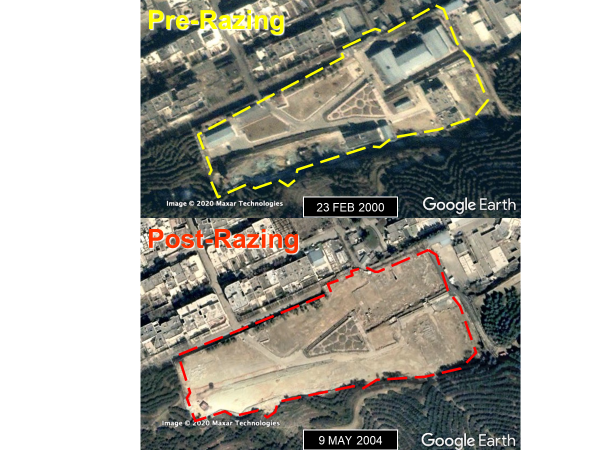
Figure 2. Lavisan site on August 11, 2003 vs. March 22, 2004, before and after razing. The razing was part of Iran’s effort to hide the Amad program and earlier nuclear weapons programs. The razing also shows the site’s boundaries.
In a memorandum, portions shown in Figure 3, dated June 23, 2002, addressed to the head of Project 3, the memo’s unidentified author proposed to build and equip a “temporary workshop.” Sensitive terms such as “uranium” are avoided, typical of many of the documents in the archive, yet not surprising since this is a highly secret nuclear weapons program. With that in mind, and remembering the purpose of Project 3.14, the subject of the memorandum is straightforward to understand, in essence a proposal to build a small processing plant for the “main metal,” a codeword for uranium, including in particular weapon-grade uranium. “Main site” stands for Shahid Boroujerdi. The memorandum lists the proposed goals of the temporary workshop:
- Gaining experience and practical knowledge with metals similar to the main metal and with the main metal.
- Using the results and gained experience to review the design of the main site’s workshops, including space, equipment, materials, etc.
- Using the results and gained experience to review the design of matters related to safety and health pertaining to the processes.
Since Project 3.14 viewed the pilot plant as temporary, its equipment and personnel would likely be transferred to Shahid Boroujerdi once the main plant was nearing completion. If Shahid Boroujerdi failed to become operational by the time the first batch of nuclear explosive material was available, the pilot plant could have served another temporary purpose as well, producing the first weapon-grade uranium core of a nuclear weapon.
An undated Iranian PowerPoint presentation presented Project 3.14 in broad terms, with one slide, titled “Course of Action,” listing the steps necessary for this project (see Annex for this and additional excerpts from this presentation, translated into English):
Defining the project and planning workshops and labs
Cover plan (see below)
Site selection
Organization
Laying out a basis for scientific and practical actions
Research projects
Furnace manufacturing
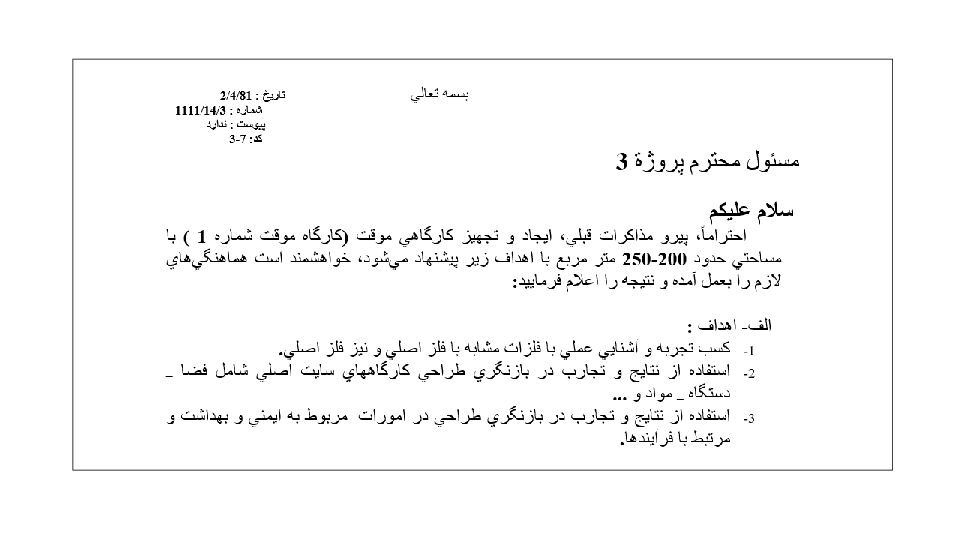
Date: 23.06.2002 (Persian calendar 2/4/81)
Serial number: 1111/14/3
Annex: none
Code: 3-7
Honorable Project Manager of Project 3
With Greetings
With regards, further to previous conversations, it is hereby proposed to construct and equip a temporary workshop (temporary workshop number 1) of an area of about 200-250 square meters with the following goals, thus, please perform necessary coordination and announce the results:
A –Goals
-Gaining experience and practical knowledge with metals similar to the main metal and with the main metal.
-Using the results and gained experience to review the design of the main site’s workshops, including space, equipment, materials, etc.
-Using the results and gained experience to review the design of matters related to safety and health pertaining to the processes.
Figure 3. Excerpts of original memorandum, dated June 23, 2002, above, from the Nuclear Archive, with English translation below. The serial number may reflect project 3.14, followed by a sequential number, where in American English “/” translates to “.”.
One month after this proposal, site selection was far along, Project 3.14 favoring a site at the Aerospace Industries Organization (AIO) Mechanical Industries facilities in Hakimiyeh, also known as the Shahid (Martyr) Hemmat Industrial Group (SHIG).5 Figure 4 shows a Farsi-language memorandum to the head of Project 3, dated July 16, 2002, discussing a visit a few weeks earlier to inspect a disused “textile workshop” and smaller adjacent workshops in a partially deserted section in the southeastern section of the SHIG complex. The English translation of the main text of the memorandum follows (full translation in Figure 4):
With regards, further to previous coordination regarding the establishment of the small workshop for the execution of Project 3.14, on 04/07/2002, the project’s representative for matters related to the site (Mr. engineer Aghamohammadi) and the honorable logistical manager of Project 3 (Mr. engineer Farazandeh Nia) surveyed the available facilities in the location of the Mechanical Industries Department of the Aerospace Organization in Hakimiyeh, which its details will be noted below:
1- The surveyed area is located in the southeastern part of the industry, and currently, its main workshop, the so-called Textile Workshop, is almost semi-deserted and is used only as wood storage.
2- This workshop is in an area with dimensions6 80m * 20m and meets the qualifications and specifications for industrial structures, and its space is sufficient to conduct metallurgy work and machining.
3- In the vicinity of this workshop, two other workshops, so-called the Tanker Making Workshop and the Research Department, are located. The first workshop is active and the second workshop’s equipment are being transferred to another location. If this section would meet the working requirements, in the near future, these two workshops can be added to the complex.
Given that obtaining the opinion of group 7 and 147 regarding the noted location is mandatory, it is suggested that the honorable project manager would order cooperation about this matter. [Comment: Group 7 is the Health and Safety Group of the Amad Plan.]

Date: 07/16/2002 (Persian Calendar: 25/4/81)
Serial number: 1154/14/3
Attachment: yes
Code: 14-3
To: Honorable Project Manager of Project 3
With Greetings
With regards, further to previous coordination regarding the establishment of the small workshop for the execution of Project 14/3, on 04/07/2002, the project’s representative for matters related to the site (Mr. engineer Aghamohammadi) and the honorable logistical manager of Project 3 (Mr. engineer Farazandeh Nia) surveyed the available facilities in the location of the Mechanical Industries Department of the Aerospace Organization in Hakimiyeh, which its details will be noted below:
1- The surveyed area is located in the southeastern part of the industry, and currently, its main workshop, the so-called Textile Workshop, is almost semi-deserted and is used only as wood storage.
2- This workshop is in an area with dimensions 80m * 20m and meets the qualifications and specifications for industrial structures, and its space is sufficient to conduct metallurgy work and machining.
3- In the vicinity of this workshop, two other workshops, so-called the Tanker Making Workshop and the Research Department, are located. The first workshop is active and the second workshop’s equipment are being transferred to another location. If this section would meet the working requirements, in the near future, these two workshops can be added to the complex.
4- Given that obtaining the opinion of group 7 and 148 regarding the noted location is mandatory, it is suggested that the honorable project manager would order cooperation about this matter.
Figure 4. Memorandum recommending a site inside the Hemmat Industrial Group (SHIG) complex, from the Nuclear Archive.
The site offered several advantages, the three buildings isolated within a military site, all located in a depression, obscured the building’s view from adjacent areas, including public roads, helping to hide them from adversaries by a means known as “terrain masking”. Figure 5 is a commercial satellite image of the broader area from January 10, 2020, showing the location of the workshop relative to SHIG and nearby ballistic missile research, development and test facilities, all located east of Tehran. Figure 6 is a March 2, 2003 Maxar Technologies image of the site in relationship to the surrounding SHIG facilities.
At the time, SHIG was responsible for Iran’s liquid-fueled ballistic missile program, including the medium-range Shahab-3, the Amad Plan’s choice for delivering its nuclear warheads. Putting the nuclear metallurgy pilot plant at SHIG was like a homecoming, since according to information from Western government sources, SHIG was the first home of Iran’s nuclear weapons program in the mid-to-late 1980s.9
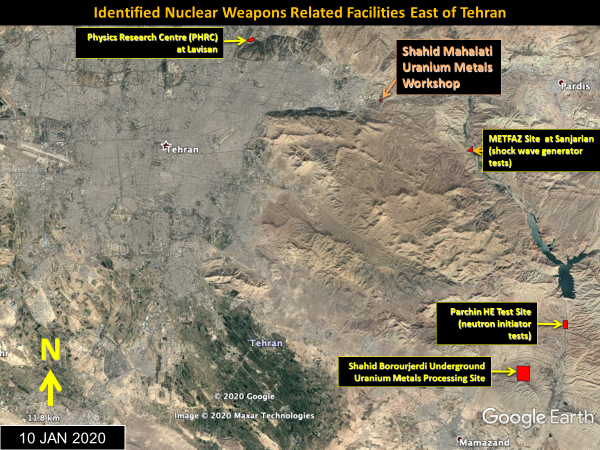
Figure 5. The uranium metals workshop is shown in relation to other previously identified nuclear weapons related sites within the broader area of eastern Tehran.
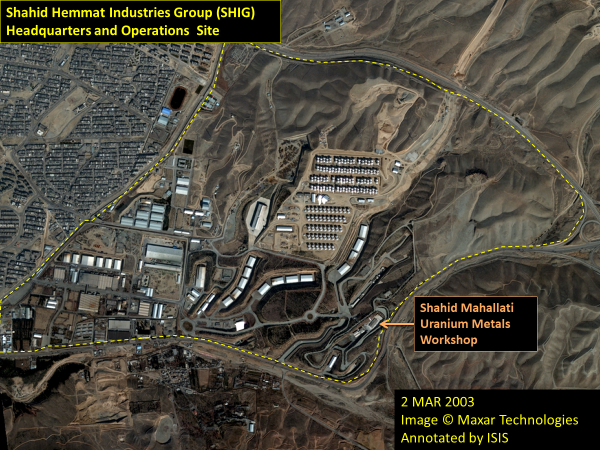
Figure 6. The uranium metals workshop is shown in relation to surrounding Shahid Hemmat Industries Group (SHIG) facility located east of Tehran.
The choice of this site to make weapon-grade uranium cores at the Hemmat Industrial Group is reminiscent of a similar siting decision by South Africa’s military nuclear weapon program, operated by the armaments company Armscor. It decided to site its first plant to make nuclear weapons in the Circle building at the Gerotek facility, an Armscor site to test military vehicles at high speeds and on various road surfaces and grades.10 (On a lighter note, one cannot help but notice that Circle and Project 3.14 are related via π.)
By embedding a nuclear site in a missile and aircraft production area, Iran may have intended to deny access to international inspectors to the entire SHIG site, if they were ever to get wind of the secret uranium plant, reducing further the chance of discovery by foreign powers or the IAEA. Indeed, the IAEA was apparently unaware of this site prior to the seizure of the archives, but now, with that awareness, its inspectors will likely face challenges to gaining access to this location as indicated in the most recent IAEA Nuclear Non-Proliferation Treaty safeguards report.11
Construction at the pilot plant moved forward quickly. By the end of April 2003, less than a year after the site was selected, construction was almost finished. An activity report on both the temporary and the main site, dated April 30, 2003, offers a comparison in progress at the two Project 3.14 sites. According to the Iranian activity report, at the temporary site:
In general, it could be said that with the exception of the installation of the main air ventilation filters, all other activities have been completed. Now, the 1200 square meter industrial structure, which had 9 separate halls, is converted to 6 main workshops, a Melting Furnace Control Center, Quality Control Center, Air Filtering and Purifying Central Location, Assembly Center, and the Safety Department.
(Comment: Although the area is here given as 1200 square meters, the extended roof area was measured on Google Earth to be ~1750 square meters (66 by 26.5 meters), yielding a probable total internal floorspace closer to 1600 square meters. This area of 1200 square meters, however, may refer to the building’s original floorspace prior to the building’s renovation and expansion. The 2002 image (Figure 1) gives a roof area of about 1425 square meters, or a floor space of 1280 square meters, assuming a ratio of 0.9. Moreover, the exact meaning of “industrial structure” is unclear in the sense that bays, offices, and other areas may not be included.)
Progress at the Shahid Boroujerdi facility was also occurring. According to this activity report:
The linings of the two workshops (floor, walls, and ceiling) are fully complete, and the lining of other workshops are being advanced in parallel. The outlet for the filtered air is fully installed, and the areas that for the machines’ establishment required excavation and positional height increase are completed.
The activity report states that photos of the progress “will be presented in the Technical Committee meeting,” likely the one for the Operating System Project of Project 3, alternatively called Project 110.12 Another document from the archive, also dated Spring 2003, contains images of the progress at Shahid Boroujerdi, available in the Institute publication, A Key Missing Piece of the Amad Puzzle: The Shahid Boroujerdi Project for Production of Uranium Metal & Nuclear Weapons Components. Figure 7 shows two images of the construction progress at Shahid Boroujerdi, consistent with the April 2003 activity report of the main site. As far is known by the Institute, no equipment had yet been installed at Shahid Boroujerdi.
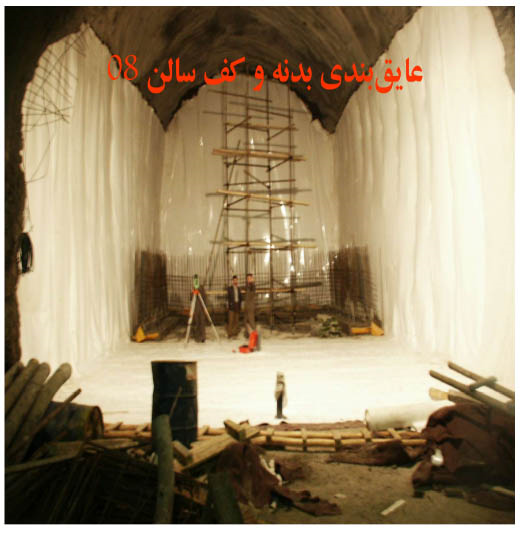
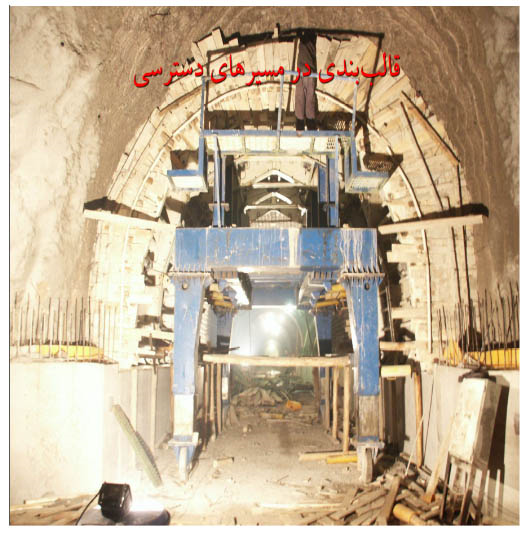
Figure 7. Construction Progress at Shahid Boroujerdi in spring 2003, images from Nuclear Archive.
In contrast, the activity report shows that progress was faster at the pilot plant than at the main site. This implies the temporary site was likely to reach a capability to make cores for nuclear before Shahid Boroujerdi.
Figure 8 has a series of Iranian images from the Nuclear Archive, showing construction of the pilot plant. The images demonstrate extensive renovation of the buildings, the digging of two pits adjacent to the main workshop, scaffolding on the main building, and the installation of metal ducting running from the uranium workshop to a building on an adjacent hill. Figure 9 has images from the archive of the largely finished facility.
The ground images can be correlated with commercial satellite imagery of the site. Several features in the ground images, including two covered square pits, ventilation ducting, air conditioning units, a new fence, and twin exhaust stacks in a supporting building, are visible in commercial satellite images of these buildings (see Figure 10).
The early March 2003 commercial satellite image in Figure 1 confirms what the April 2003 activity report states: construction was nearly complete. The commercial satellite images in Figure 1, representing in essence before and after images of the external construction, show the extensive modification of the workshop building, including its expansion in both width and length, with an expanded roof cover and the addition of a small annex on the south end where air conditioning (AC) units were added. The satellite images in Figure 1 also show that the ground images of construction were taken between July 2002 and March 2003.

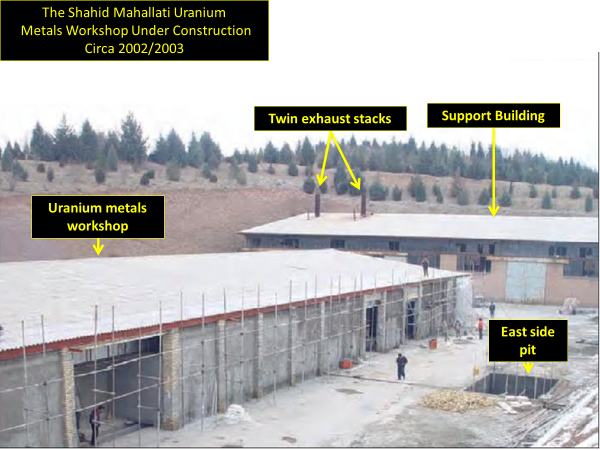
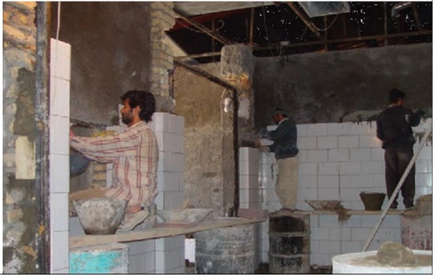
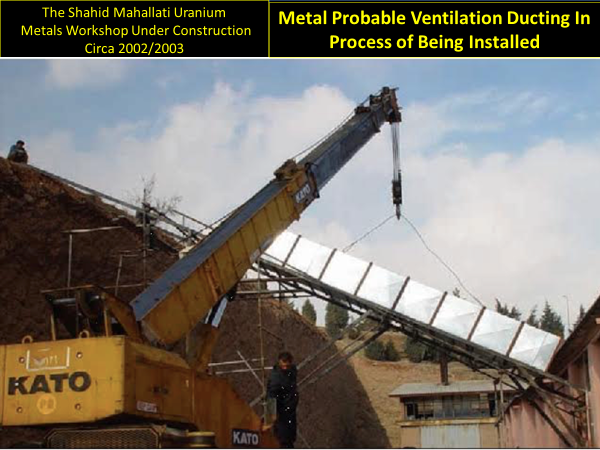
Figure 8. Iranian archive images of construction of the uranium metals workshop, the top photos show construction of two pits adjacent to the uranium workshop, the bottom photos show indoor construction and the placement of metal ducting. The images are from the Nuclear Archive and annotated by the Institute.
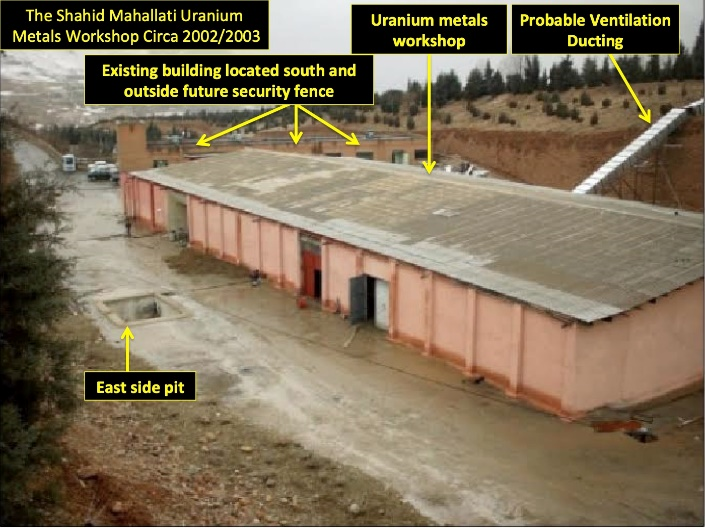

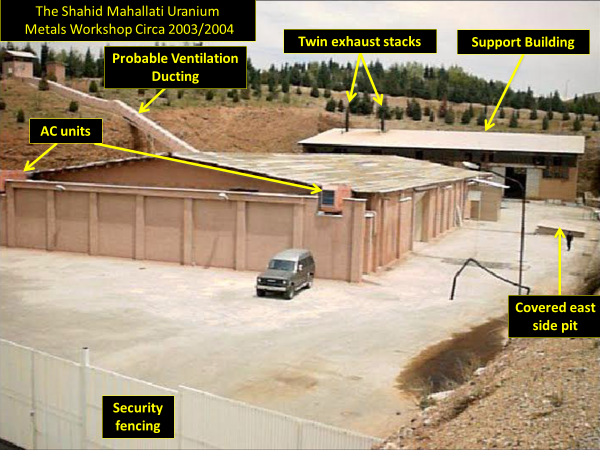
Figure 9. Nearly complete uranium workshop. Visible in upper images, metal ducting, two air conditioner (AC) units, and one of two pits without a cover; visible in lower image, a covered pit and a security fencing. All images from the Nuclear Archive, annotated by the Institute.
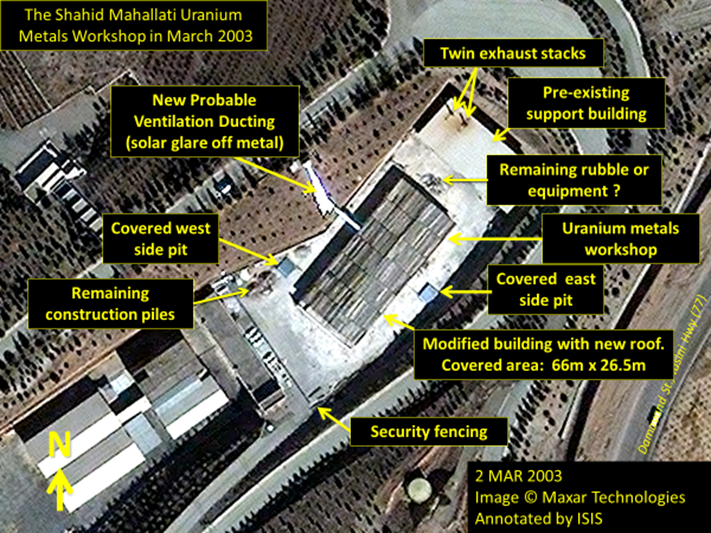
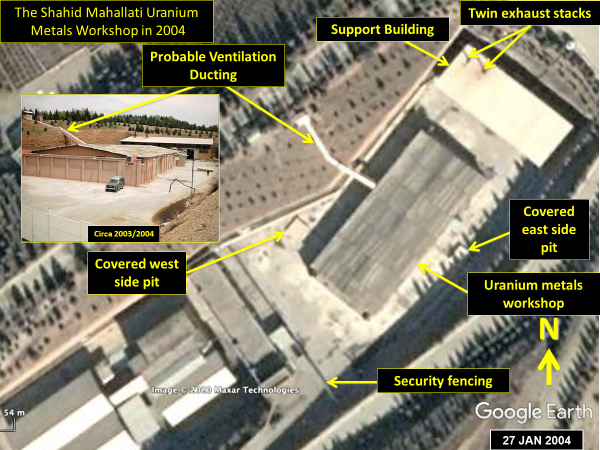
Figure 10. At top, a Maxar Technologies image from March 2003 (also shown in Figure 1). It shows the site mostly completed by this time, with the fence and ventilation duct in place, the pits covered, and only a few piles of rubble or equipment left outside. At bottom, a Google Earth image from January 27, 2004, of the uranium metals workshop, which correlates perfectly with the ground images from the Nuclear Archive as shown in the inset. The location of the fence opening matches the location of the gate visible in ground photos.
The pilot plant had to accomplish several tasks, some of which are illustrated by images at the site or other available information. The main tasks are:
- The reduction of uranium tetrafluoride to uranium metal using a reducing agent, resulting in a solid piece of uranium metal under a cover of slag. The uranium may be depleted, natural, or fully enriched uranium;
- The preparation of crucibles for use in a furnace;
- The melting of the uranium metal in a vacuum induction furnace;
- The pouring of the metal into molds;
- The finishing of cast pieces;
- The plating of uranium metal components, to protect against the oxidation of the highly reactive uranium metal;
- The assembly of the components into a final core;
- Special procedures to prevent criticality of weapon-grade uranium;
- Specialized storage vaults to protect against criticality and ensure safety;
- The operation of laboratories for quality control, material accounting, metallurgy, and chemical analysis; The processing of waste.
A key task, apparently finished by the end of April 2003, was the manufacture and installation of a vacuum furnace, a task with its own heading in the steps under “Course of Action” discussed above and listed as a “melting furnace control center” in the activity report. A decade earlier, the Physics Research Center sought to buy from various Western suppliers vacuum induction furnaces suitable for melting uranium but apparently failed in these efforts, thwarted by tightening supplier export controls.13 In response, Iran appears to have concentrated on building its own vacuum induction furnaces, albeit likely by buying subcomponents and related equipment abroad. Israeli briefers stated in November 2018 that Iran had acquired abroad at least components of vacuum induction furnaces for use in its metallurgical project.
The metal ducting structure visible in the imagery may have been for the ventilation of uranium-laden gases or other toxic gases. The main ventilation filters, which were not yet installed as of the April 2003 activity report, may have been located in the small building on the hill at the end of the ducting or inside the main uranium workshop.
The temporary site had a variety of machine tools, likely for making and finishing components. Figure 11 has Iranian images of two computer numerically controlled machine tools in the pilot plant, a milling and turning machine, with unidentified manufacturer. Given the expense of these machine tools, Project 3.14 would be expected to have planned to move them eventually to the Shahid Boroujerdi facility.
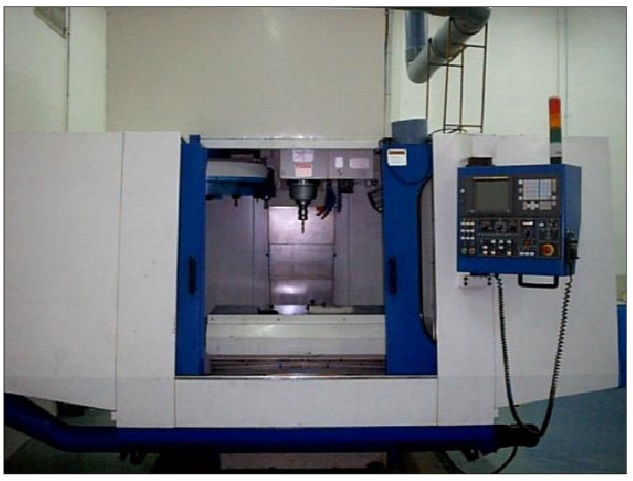
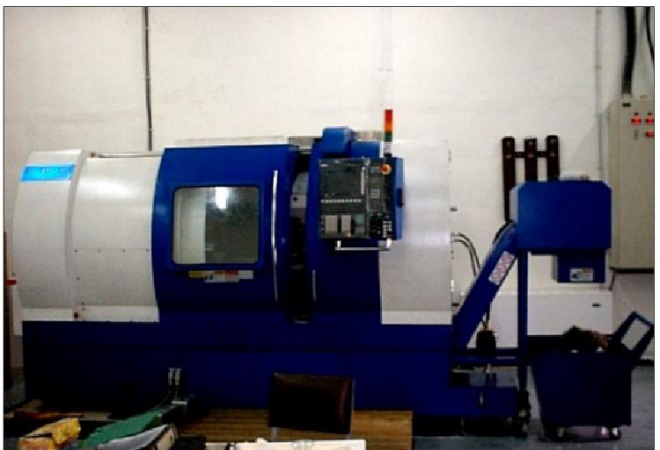
Figure 11. Computer Numerically Controlled Machine Tools in the Uranium Metals Workshop, from the Iranian Nuclear Archive.
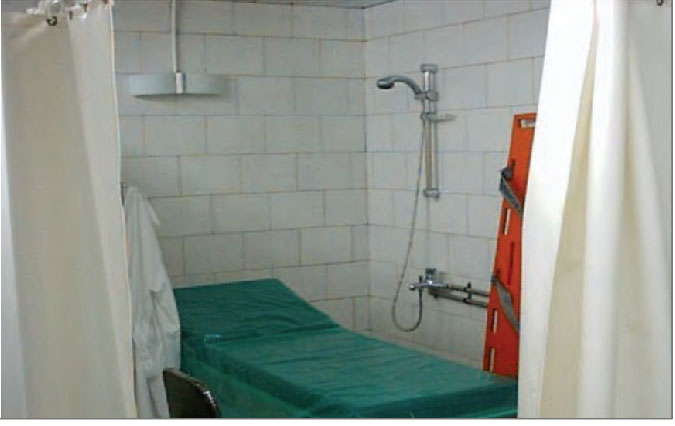
Figure 12. Examination room in the Uranium Metals Workshop, image from Nuclear Archive.
The site had a safety section, likely charged with protecting workers against accidents and radioactive contamination and treating them if affected. Figure 12 shows an apparent curtained portion of a medical examination or treatment room, containing an examination bed, a shower, and possibly a plastic stretcher, items expected in a safety section of a plant.
On either side of the uranium metals workshop, two pits were dug and at least one was lined; both were later covered. The exact purpose could not be ascertained from available documents but they could be related to storing processed wastes.
The imagery shows that a support building has two exhaust stacks, which were present before the re-purposing of the site. They were likely for diesel generators, but they could have possibly been to exhaust other furnaces. Other buildings in the SHIG complex feature similar stacks and roof discoloration around them; in some cases, the roof discoloration appears more distinct.
A security fence was constructed between the uranium workshop and an adjacent building, implying the pilot plant had two principal buildings, the workshop and a support building (see Figure 9). The purpose (if there was any) of the third building outside the security fence could not be determined (see Figures 8 and 9, top left).
Another image (Figure 13) from the archive shows that a celebration of some type was prepared, perhaps for the opening of the workshop or Eid al-Ghadir, which took place in August 2003. The image shows a room being decorated, with a banner with a famous Shiite Arabic hadith, “Whoever I am his master, Ali is master.”
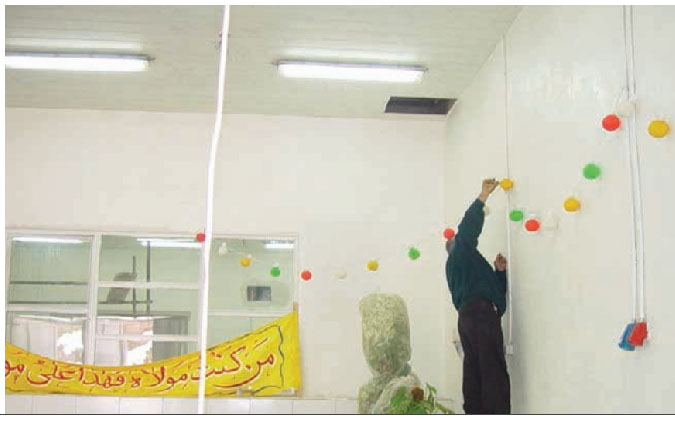
Figure 13. A celebration of some type being prepared, a banner with a famous Shiite Arabic hadith, “Whoever I am his master, Ali is master.” Someone is installing lights or decorations on the walls of a room.
At some point after the April 2003 activity report, the plant commenced operation, perhaps in the summer as possibly suggested by the image in Figure 13. The furnace may have suffered from flaws. Nonetheless, it was used to make a number of simulant or surrogate material components, and the melted material was cast and finished into what are evidently nuclear weapon shapes (see Figure 14). In a briefing, based on Iranian documents and photographs in the archive, a senior Israeli intelligence official described the level of work with surrogate materials as “massive.”14
The substance and quality of the components in Figure 14 could not be ascertained. In general, we cannot evaluate how well the site operated. Despite being externally complete by March 2003, it remains unclear if the site, despite being explicitly designed to process uranium, processed any, in any form. However, senior Israeli officials, deeply knowledgeable about the Nuclear Archive, stated that the site was ready to process uranium and awaiting orders to do so.

Figure 14. Molten material, along with cast hemispheres, in the pilot plant, Iranian images from the Nuclear Archive. It is not clear what type of surrogate material is in these images from the archive, based on the information available to the Institute.
Cover Story
The list of tasks for Project 3.14 has a surprising entry in “Course of Action” discussed above and, in the Annex, namely a “cover plan.” Project 3.14 listed the cover plan as the second bullet, right after planning the facility and before site selection. This slide implies that developing a cover story was integrated into the earliest planning for the facilities in Project 3.14. Cover stories, which can be elaborate, can reduce the chance of detection by overseas intelligence services or the IAEA, and they ease the task of acquiring needed goods abroad. A cover story would reduce the number of construction workers, including construction engineers, knowledgeable about the true purpose of the plant. Employees could also be kept in the dark until uranium is introduced. The priority given to a cover plan suggests the extent of concern about leaks in the program and foresight about the possible need for future deniability of the true nature of Project 3.14’s activities.
According to the PowerPoint presentation in the archive that discusses Project 3.14, the cover for the pilot plant was titanium production, which has many similarities to uranium metallurgy, according to the Iranian presentation in the archive (see Annex). The reasons for this choice focus on using an industrial, approved cover plan with similarities to uranium in terms of its manufacturing processes. The similarities listed include production methods, machining capabilities, and melting methods. The document stated that this cover plan also eased the interfaces with other Iranian centers and personnel, allowed the gaining of experience and skill in a similar field, provided potentially a financial benefit for the program, and answered to an industrial need in Iran, including in petrochemistry and refineries, maritime industries, military industries, and aeronautics.
Such a strategy is not unprecedented for countries that have signed the Nuclear Non-Proliferation Treaty, pledging to undertake only peaceful nuclear activities and to never build nuclear weapons. Taiwan’s subterfuge is perhaps the best documented case, centering on hiding its nuclear weapons program until 1988, when it was shut down under intense U.S. pressure.15 Taiwan developed highly sophisticated cover stories, including for its nuclear weapons code development and its plutonium production and separation efforts, plutonium being Taiwan’s nuclear explosive material of choice.16
Fate of the Pilot Plant
With the closure of the Amad Plan in the fall of 2003, Project 3.14 appears to have been shut down, at least the Shahid Boroujerdi site, which exhibits some indications that it could have been repurposed to another military task. 17 The fate of the pilot plant, however, is less clear, based on available information. The site may have functioned after 2003, sat idle, or perhaps remained on standby for eight years (see Figure 15). Until that time, the site looked intact and could have remained operationally ready.
Commercial satellite imagery shows that between November 2010 and April 2011 the uranium metallurgy workshop building was dismantled, with the removal of the ventilation ducting and the appearance of demolition debris (see Figures 16 and 17). It appears that the two square pits were infilled. After April 2011, the building appears to have been abandoned (see Figure 18), as indicated by observable roofing disrepair. It will likely never serve in its original capacity again.
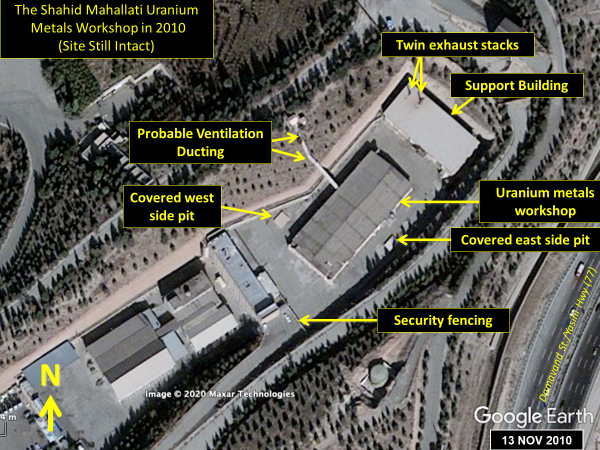
Figure 15. The Uranium Metals Workshop appeared to be intact in a November 13, 2010 Google Earth image.

Figure 16. Extensive removal and demolition work is visible in an April 27, 2011 Google Earth image.
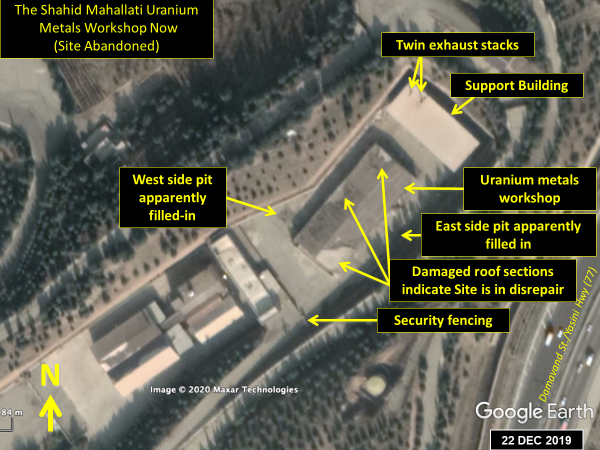
Figure 17. A recent Google Earth image showing apparently abandoned buildings
Taking Stock
The pilot plant appears to have been largely finished and had become operational. It appears to have been ready to start work with uranium in the spring/summer 2003.
It was designed as a temporary research and development site for the forming of uranium metal fissile cores, serving as the template for operations destined underground at the Shahid Boroujerdi tunnels site at Parchin.
Surrogate nuclear core components were produced at the site. It is unclear if further assembly occurred with these hemispherical components. It is also not known if the site handled natural or depleted uranium as a surrogate for weapon-grade uranium. It is more certain that the site did not handle any highly enriched uranium, including weapon-grade uranium.
The pilot plant would have been capable of making the first nuclear core of a nuclear weapon. If Iran had produced, or otherwise acquired, enough weapon-grade uranium for a bomb, and if Shahid Boroujerdi had not yet become operational, then this facility could have produced the first weapon-grade uranium components of nuclear weapons.
It is unknown when the pilot plant was closed or equipment evacuated. The plant may have continued operation or been on standby after 2003, but certainly not after late 2010 or early 2011. The main workshop building appears abandoned today. The fate of the equipment, including sophisticated machine tools and vacuum furnaces, is unknown. The post-Amad military organizations, such as the Organization of Defensive Innovation and Research (SPND), likely inherited many of the personnel and capabilities of Shahid Mahallati, intending to at least maintain skills, if not advance capabilities. Iran may have hidden some of Shahid Mahallati’s assets and materials at Turquz Abad, a secret site unmasked by Israel in 2018 and later visited by the IAEA.
As in many other cases, Iran has clearly been dishonest with the IAEA. During discussions in September 2015, _“Iran informed the Agency that it had not conducted metallurgical work specifically designed for nuclear devices, and was not willing to discuss any similar activities that did not have such an application.”_18 The activities at Shahid Mahallati and Shahid Boroujerdi are a dramatic contrast to that statement, activities highlighting once again that Iran furthered its nuclear weapons capabilities far more than was known prior to Israel’s seizure of the Nuclear Archive, permitting Iran today to build nuclear weapons faster than previously believed. Despite this chilling assessment, the new details in the Nuclear Archive now confront Iran, demanding that it admit to its deceptions and falsehoods, as if the Nuclear Archive is reality denied coming back to haunt Iran. 19
Annex
Farsi Document: Activity report dated April 30, 2003, from the Nuclear Archive
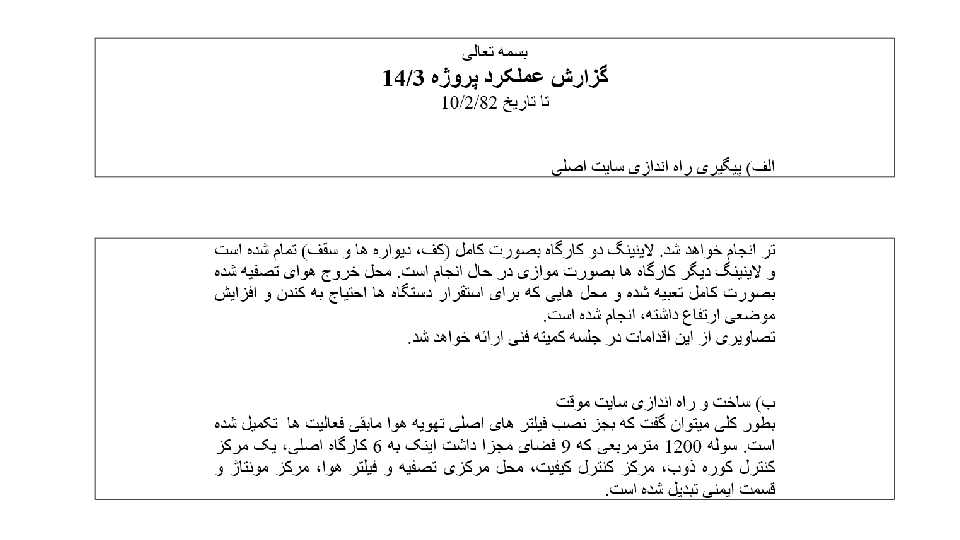
English Translation of Activity report dated April 30, 2003 (above), from the Nuclear Archive, with translator’s comments embedded in the text
Project 3.14 Performance Report
until date 04/30/2003 (Persian Calendar: 10/2/82)
A) Follow up with setting up the main site
[Translator Comment: The following text is the continuation of some previous pages as the first sentence starts with the end of a missing sentence.]
… more will be done. The linings of the two workshop (floor, walls, and ceiling) are fully complete [Translator Comments: the phrase lining was used in Farsi, and a Google search in Farsi suggests that the phrase mostly used for concrete lining, particularly for canals, so the buildings are likely built with concrete, and maybe the canal part indicates that they are underground.], and the lining of other workshops are being advanced in parallel. The outlet for the filtered air is fully installed, and the areas that for the machines’ establishment required excavation and positional height increase are completed.
Photos of these actions will be presented in the Technical Committee meeting.
B) Constructing and setting up the temporary site
In general, it could be said that with the exception of the installation of the main air ventilation filters, all other activities have been completed. Now, the 1200 square meter industrial structure, which had 9 separate halls, is converted to 6 main workshops, a Melting Furnace Control Center, Quality Control Center, Air Filtering and Purifying Central Location, Assembly Center, and the Safety Department.
Translation of excerpts of an Iranian Nuclear Archive PowerPoint discussing Project 3.14, relevant to the “cover plan” of Shahid Mahallati, where Ti stands for titanium
Slide #1
Project 3,14
Slide #2 Courses of action: - Defining the project and planning workshops and labs - Cover plan - Site selection - Organization - Laying out a basis for scientific and practical actions - Research projects - Furnace manufacturing
Slide #14 Part two
Slide #15 Ti Plan: - Reasons for reviewing the Ti manufacturing plan - Feasibility studies
Slide #16: Reasons for choosing the Ti manufacturing plan: - Using an industrial, approved cover plan - Similarity to many manufacturing processes: o Similarity of production method o Similarity of machining capabilities o Similarity of melting methods - Easing interfaces with centers and personnel - Gaining experience and skill in a similar field - Financial benefit for the program - Answering to an industrial need in Iran o Petro chemistry and refineries o Maritime industries o Military industries o Aeronautics
Iranian Pathway to a Nuclear Weapon Under the Amad Plan – What we learned from the Nuclear Archives
1. David Albright, Olli Heinonen, Frank Pabian, and Andrea Stricker, “A Key Missing Piece of the Amad Puzzle: The Shahid Boroujerdi Project for Production of Uranium Metal & Nuclear Weapons Components,” Institute for Science and International Security, January 11, 2019, https://isis-online.org/isis-reports/detail/summary-of-report-a-key-missing-piece-of-the-amad-puzzle-the-shahid-borouje/8 ↩
2. The Institute uses the convention of referring to 3/14 in a Farsi document as 3.14, where the “/” is translated as a “.” Sometimes, the Farsi document uses 14/3, reflecting reading from right to left, which is also translated as 3.14. ↩
3. “A Key Missing Piece of the Amad Puzzle: The Shahid Boroujerdi Project for Production of Uranium Metal & Nuclear Weapons Components.” https://isis-online.org/isis-reports/detail/a-key-missing-piece-of-the-amad-puzzle ↩
4. Director General of IAEA, “Implementation of the NPT Safeguards Agreement in the Islamic Republic of Iran,” GOV/2005/87, 18 November 2005. ↩
5. Hemmat is also spelled as Hemat.↩
6. The measurements 80 * 20 square meters defining an area containing the workshop are difficult to interpret, since they are not given as an area of the workshop. ↩
7. Translator’s comment: The use of the singular group when referring to plural is relatively common in Farsi, where here the translation is referring to both group 7 and group 14. There is no slash between 7 and 14, so it is not 7/14. ↩
8. Translator’s comment: The use of the singular group is relatively common in Farsi, when the translation is referring to the plural, here both group 7 and group 14. There is no slash between 7 and 14, so it is not 7/14. ↩
9. David Albright, Paul Brannan, and Andrea Stricker, “The Physics Research Center and Iran’s Parallel Military Nuclear Program,” Institute for Science and International Security, February 23, 2012, http://isis-online.org/uploads/isis-reports/documents/PHRC_report_23February2012.pdf See also Institute web site page, PHRC Documents, http://isis-online.org/phrc ↩
10. Frank V. Pabian (2015) The South African Denuclearization Exemplar, The Nonproliferation Review, 22:1, 27-52, DOI: 10.1080/10736700.2015.1071969 https://www.tandfonline.com/eprint/5nWGiVQ5CevyjqXrjWJe/full and Albright with Stricker, Revisiting South Africa’s Nuclear Weapons Program (Washington, DC: Institute for Science and International Security, 2016), available at Amazon, Barnes and Noble, and other booksellers and as a pdf at https://isis-online.org/uploads/isis-reports/documents/RevisitingSouthAfricasNuclearWeaponsProgram.pdf ↩
11. NPT Safeguards Agreement with the Islamic Republic of Iran, GOV/2020/15, March 3, 2020, https://isis-online.org/uploads/iaea-reports/documents/IAEA_Iran_NPT_March_2020_report.pdf ↩
12. See Project 110 organizational chart in isis-online.org/isis-reports/detail/from-irans-nuclear-archive-organizational-chart-of-project-110-amad-supraor/8 ↩
13. The Physics Research Center and Iran’s Parallel Military Nuclear Program. ↩
14. Briefing of Albright, by telephone, June 6, 2018. ↩
15. David Albright and Andrea Stricker, Taiwan’s Former Nuclear Weapons Program: Nuclear Weapons On-Demand (Washington, DC, Institute for Science and International Security, 2018). https://isis-online.org/books/detail/taiwans-former-nuclear-weapons-program-nuclear-weapons-on-demand/15 ↩
16. Ibid. ↩
17. “A Key Missing Piece of the Amad Puzzle: The Shahid Boroujerdi Project for Production of Uranium Metal & Nuclear Weapons Components.” ↩
18. IAEA Director General, Final Assessment on Past and Present Outstanding Issues regarding Iran’s Nuclear Programme, GOV/2015/68, December 2, 2015, https://www.iaea.org/sites/default/files/gov-2015-68.pdf ↩
19. Last phrase is paraphrased: “Reality denied comes back to haunt,” Philip K. Dick, Flow My Tears, the Policeman Said. ↩

 twitter
twitter